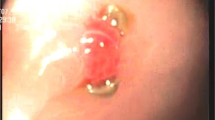Abstract
Rectal bleeding following colorectal anastomosis is common but usually self-limited. Continuous hemorrhage is rare, and when it occurs, often requires further treatment. The most frequently used strategies for treatment of stapled anastomotic hemorrhage are clinical observation with or without blood transfusion, rectal packing, angiographic identification of the bleeding site with vasopressin infusion or embolization, and endoscopic eletrocoagulation. We report the case of a 49-year-old man with uncomplicated diverticular disease who was treated by laparoscopic sigmoidectomy, with double-stapled colorectal anastomosis. Six hours later, the patient presented intense rectal bleeding and was taken to the operation room for urgent colonoscopic examination. After complete removal of blood clots inside the rectum, a bleed localized at the anastomotic site was identified and submucosal peri-anastomotic injection of 10 ml adrenaline (1:200 000) in saline was performed with immediate bleeding control.
Similar content being viewed by others
Author information
Authors and Affiliations
Corresponding author
Rights and permissions
About this article
Cite this article
Perez, R.O., Sousa, A., Bresciani, C. et al. Endoscopic management of postoperative stapled colorectal anastomosis hemorrhage. Tech Coloproctol 11, 64–66 (2007). https://doi.org/10.1007/s10151-007-0330-5
Received:
Accepted:
Published:
Issue Date:
DOI: https://doi.org/10.1007/s10151-007-0330-5




